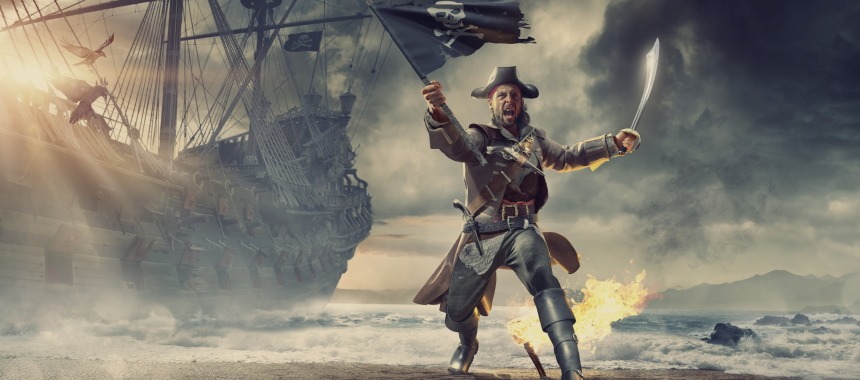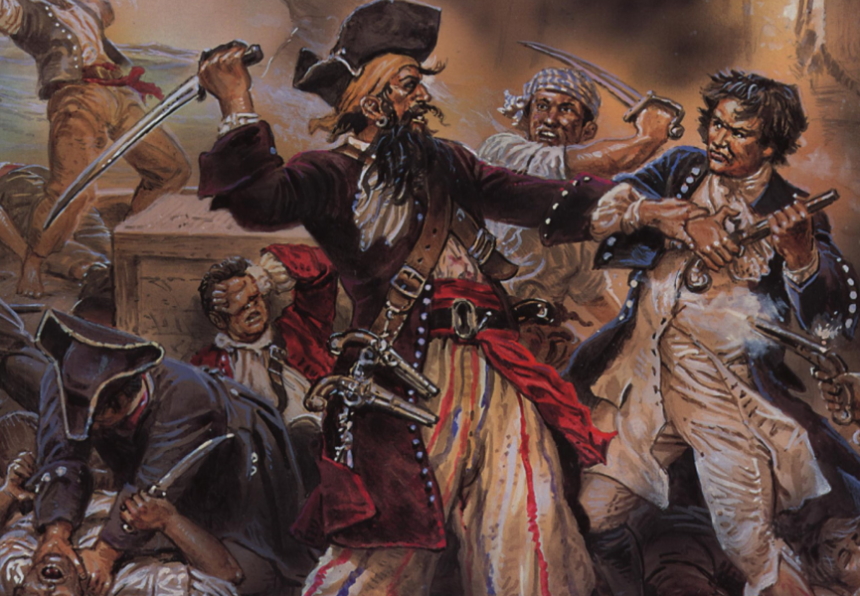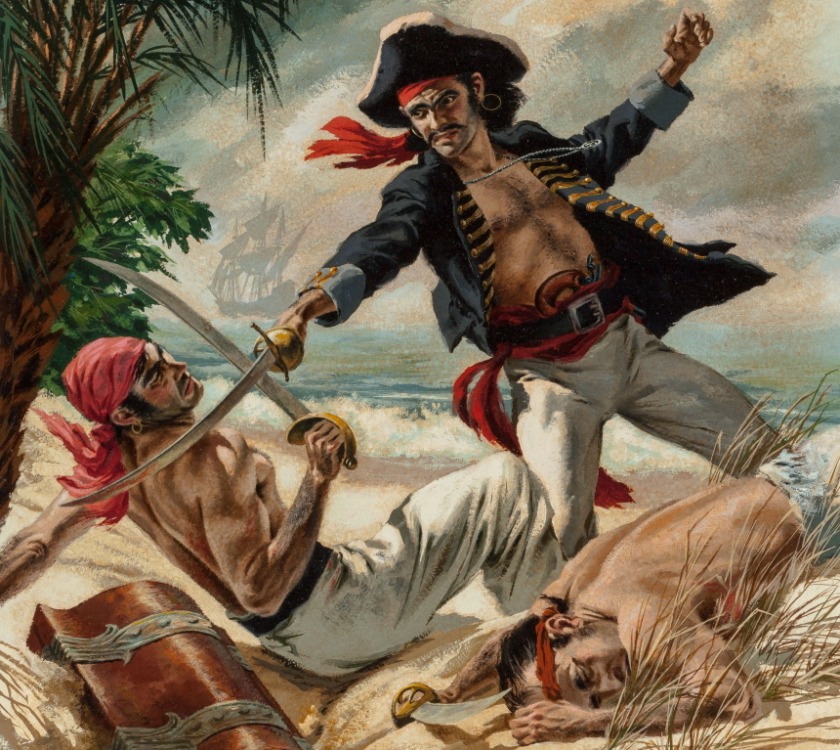The real history of the emergence of pirates

Thanks to literature and films, Caribbean pirates are depicted either as mythical and fearless heroes or as malicious cutthroats cursing their way through children's imagination. However, pirates were real people who lived in the 17th and 18th centuries, raiding trading ships transporting goods across the Caribbean from the New World colonies. Legends of their misdeeds have long outlived them.
Many pirates were mere petty thieves and adventurers sailing on enormous ships. Others were notorious villains whose actions further degraded their human image, bringing neither happiness nor wealth. They squandered all their plundered gold on drink and revelry. Yet, there were those compelled to take to the seas due to poverty and the desire for a somewhat decent existence, but often their attempts led to even harsher fates. Like their contemporaries, highwaymen, the most infamous pirates became self-proclaimed anti-heroes, exploiting their fame. Captured and executed after a fair trial, they remained forever in the minds of the common people.
In 1716, on the golden sandy beaches of the Bahamas, now frequented by tourist boats, the British government made a tearful plea. However, it was not the sporadic raids by the Spanish on the local settlement and the ships of local merchants and fishermen that prompted action. Much greater concern was the presence of a pirate colony on Providence Island, 28 miles from the Bahamas, which was not subject to any state.
The problem had reached critical proportions. The number of pirates had grown to the extent that they not only dominated the seas near Jamaica but had also moved northward. If urgent measures were not taken, any trade between Great Britain and North America's inhabitants was at risk of disruption. In response, the British government promised amnesty to all voluntarily surrendering pirates. However, this measure did not yield the desired results. The next step was to order all commanders to seize and arrest pirates who refused to surrender voluntarily, deploying special forces to carry out this directive.

On April 11, 1718, Captain Woods Rogers set sail from Bristol on his ship. This new governor now had to deal with this problem, promising amnesty to those who voluntarily surrendered to the authorities.
Just a few months after arriving at his destination, Rogers had the opportunity to demonstrate his approach to solving this problem when a pirate gang was discovered on one of the small islands. These individuals had been pardoned by the king but had returned to their old trade. All eight pirates were executed by hanging.
From the gallows docks on the Thames shore to the very Arsenal Wharf in Jamaica, this familiar scene served as a final reminder of the fate that awaited pirates.
Despite his success in ridding Providence Island of pirates, the governor acknowledged that a group of criminals, numbering around 2,000 people, still remained on the island. No colony could contain such a horde of cut-throats, especially under the leadership of the notorious pirate Edward Teach, also known as Blackbeard.
Edward Teach, whose plans Woods Rogers undoubtedly had heard of, was one of the most successful pirates of his time. In 1798, he even became the hero of a play performed on the London stage. A century later, the adventures of Blackbeard could be seen in a series based on the legends that have reached us.
Seizing a French ship and renaming it «Queen Anne's Revenge,» he armed it with 40 cannons, turning it into a true warship—one of the most powerful among pirates. Establishing a base in the Caribbean islands, he kept the inhabitants of coastal colonies in constant fear.
In 1716, when Rogers' mission to eliminate pirates was in full swing, the fleet protecting the entire Caribbean basin consisted of only four frigates. To increase the number of ships, an order was issued allowing the freedom to attack enemy vessels and seize them. Such expeditions became business ventures, aimed at conquering new lands or subduing unruly peoples.
A clear division soon emerged between captains and privateers, who later received knighthoods, and thieves and bandits attacking ships for loot. However, the line between law and piracy was so blurry that captains who gained fame during wars did not hesitate to engage in piracy during peacetime.
This region attracted adventurers with its abundant gold reserves stored in the former Spanish colony of New Spain, located in present-day Mexico. Gold, silver, precious gems from the Aztecs and Incas, along with valuable minerals mined by slaves in the mines, were transported on ships to Spain.
One of the most brutal battles of that time occurred in June 1668 under the flag of Henry Morgan. Most of the pirates under his command attacked the Spanish colonial Portobello. They were neither selfless soldiers nor patriots, but they operated under the royal flag.
Henry Morgan, with a fleet of 12 ships, was a determined captain. Portobello became their target because of the galleons carrying Spanish gold. The city was well-fortified and had enough weaponry to defend ships from any pirate attack by sea. Knowing this, Captain Morgan did not openly attack but instead placed his men in canoes, landing them under the cover of night along the coast. The land assault proved to be an ideal plan.
Threatening to burn the city to the ground, the pirates managed to secure a ransom of around 250,000 pesos, equivalent to 4 million pounds. This news led to public rejoicing in England.
However, soon both Henry Morgan and the governor of Jamaica, who had ordered this operation, were arrested and brought to Britain in 1672, indicating the fluctuating attitudes towards piracy.
Even after this, Charles II did not execute Morgan but granted him a knighthood and quickly sent him back to Jamaica with a mission to continue protecting the colony from enemy raids.
The general tactics of pirates were characterized by inadequate training and a lack of any strategy or logic. Their attacks, despite skillful ship management, were chaotic and aimed at random victims. The pirates' loot included clothing, money, bundles of goods, meat, gunpowder, ropes, flour, wine, and the like. However, even these items played a vital role in the existence of any pirate. The spoils provided the villains with food and drink, and ropes and cords went into minor repairs or were sometimes used in new attacks.
Real pirate attacks were not characterized by high choreography or superhuman feats. Sabers and pistols were usually used during skirmishes. In such cases, pirates did not hesitate to strip passengers of everything, taking their money and valuables. Sometimes, even the passengers themselves became a more coveted prize than goods. Many ships were loaded with slaves destined for plantations of sugar cane and tobacco in Jamaica.
In a crew consisting of hundreds of pirates, discipline was often maintained only through fear. Despite most gang leaders being elected by the crew, they feared potential murder or mutiny. In some crews, relationships were regulated by shares. Anyone had the right to receive food and an equal share of spirits if they were found on the captured ship. It was also stipulated which shares of the loot each member of the crew received. For example, the captain and helmsman each received two shares, the boatswain and gunner received one and a half, while other officers received one share with a quarter. Everyone was responsible for keeping their belongings, weapons, and sabers ready for use. Gambling on board was strictly prohibited. And if anyone was caught harbouring a woman on board, the offender faced inevitable death. Of course, sailors could resist such strict pirate laws, but there were no guarantees that it would be easier with another captain.

The Golden Age of piracy lasted for about 70 years, starting with the capture of British Jamaica. Despite Britain now having a stronghold in the Caribbean basin, Jamaica itself needed protection, which was provided by pirate hunters, who often switched sides to their enemies. However, some chose to satisfy their ambitions. For example, a wealthy planter from Barbados, Steve Bonny, bought a ship and assembled a team of volunteers. In March 1718, completely unfamiliar with seamanship, Bonny met Blackbeard, who immediately convinced the «greenhorn» to entrust the ship's management to a more experienced person. Although the owner got his ship back three months later, his life was permanently shattered.
However, most pirates embarked on a slippery path, either by coercion or by circumstances. The increase in the number of pirates was explained by Britain's need for new strongholds along major trade routes against Spain and France, with which England was in constant conflict. When the possibility arose to resolve political issues through peaceful means, the need for pirates diminished. However, piracy did not end its existence, as naval service came with constant restrictions and a modest salary. Piracy, on the other hand, offered freedom, strength, and a sense of lawlessness. Therefore, many chose this adventurous life, albeit a short one.
- Comments
 en
en ru
ru uk
uk